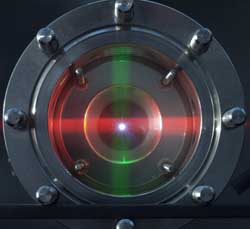Fermium Wins Heavyweight Title

Made in the 1952 detonation of the first thermonuclear bomb, the element fermium has since sat in a corner of the periodic table where few tools of chemistry reach. Now a team has captured a piece of its spectrum–the wavelengths of light it absorbs–making it the heaviest element ever to be so measured. The researchers rushed their scant sample of the short-lived element from a nuclear reactor in the US to Germany, where they probed it with lasers, just atoms at a time. Appearing in the 25 April PRL, their findings shed light on the energies of fermium’s electrons and provide a way for theorists to test their calculations for even heavier and more elusive elements.
The available energy levels for electrons in an atom determine both what kind of bonds it forms and what other elements it reacts with. Fermium is element 100–six doors past plutonium in the periodic table–and calculating the energies of its 100 electrons is a tricky business. Einstein’s relativity comes into play for the fast-moving electrons of such an atom, changing the rules that usually indicate which orbitals are most stable.
With most elements, researchers learn about the electron energy levels by detecting the wavelengths of light that atoms either emit or absorb as they switch from one quantum state to another. But collecting enough light takes either a lot of time or a lot of atoms. After almost two years of work, researchers at Oak Ridge National Laboratory in Tennessee had produced just a few billionths of a gram of pure fermium. Twenty hours later half of it would be gone, and it would continue to decay en route to Germany, where the spectrum was to be measured. There would be few atoms to work with, and the German team would have to work fast.
To measure the absorption of light in such a meager sample, a team led by Hartmut Backe and Norbert Trautmann of the University of Mainz used a trick: if an atom absorbed, they turned it into an ion (an electrically charged atom) and then detected it with sensitive commercial ion counters. For each test wavelength, the team shot a laser pulse at their sample and simultaneously pulsed it with a second laser. The second pulse was energetic enough to strip away an electron and turn an atom into an ion, but only if the atom absorbed the first pulse at the same time. For most test wavelengths, the detectors registered no fermium ions, but at two wavelengths, the detectors counted about 100 per second.
To detect ions at this rate, the researchers had to illuminate about a million atoms per second, but in chemistry, a million is barely an appetizer. “It’s an astonishingly small number of atoms they had to work with,” says University of Calgary chemist Michael Seth.
The team calculated the wavelengths of different possible quantum states and found two which matched the wavelengths that produced ions. While some experts see the match as persuasive, others are cautious, largely because such calculations usually are not very accurate. If theorists truly have a handle on heavy-atom calculations, says Seth, then probing more of the spectrum will reveal matches to the other quantum states. Norman Edelstein of the Lawrence Berkeley National Laboratory in California is hopeful that the new technique will produce more spectra in this previously inaccessible corner of the periodic table.
–Oliver Baker
Oliver Baker is a freelance science writer based in Davis, CA.


